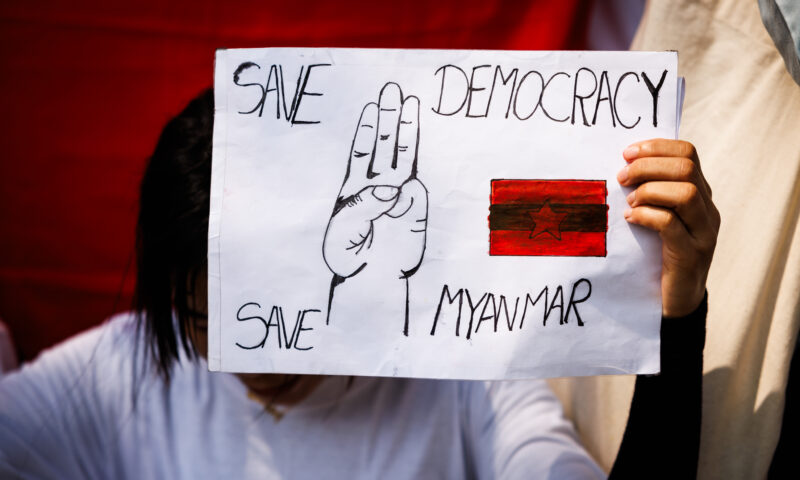Politics & Government
California Once Again Considers a Single-Payer Health-Care System
Co-published by The American Prospect

Co-published by The American Prospect
In February, California State Senators Toni Atkins and Ricardo Lara introduced Senate Bill 562, the Healthy California Act, a one-page law declaring “the intent of the Legislature to…establish a comprehensive universal single-payer health care coverage program and a health care cost control system for the benefit of all residents of the state.” But perhaps most significantly for its political fate, the bill effectively banishes insurance companies from operating in the state, ensuring that this wealthy industry will do all in its power to kill single-payer in California — as it has successfully twice before.
Announced as Congressional Republicans were strategizing to repeal and replace the Patient Protection and Affordable Care Act, also known as Obamacare, SB 562 is a clear expression of Sacramento’s mission to stake out a different path on policy from that being forged by the right-wing administration and Congress that Americans sent to Washington in November. (The bill is currently headed to the Senate’s Appropriations Committee.)
Although all other members of the Organization for Economic Cooperation and Development, the world’s wealthiest 35 democracies, have some form of single-payer, national health insurance providing universal coverage, that policy was expressly omitted from the options states could offer to consumers through the insurance exchanges they set up under ACA.
But the federal law gave states an opening: Starting this year, it said, any state would be free to choose another way if it could come up with a health-care system with equivalent or better benefits. Many who have studied the issue and compared statistics internationally, believe single-payer is the best way to insure a large population, offering better health outcomes at lower costs overall. Under single-payer everyone is covered – unlike Obamacare, or the Republican bill that would have replaced it, or the system that preceded it. It encourages people to access preventive care more often, which costs the system less than when people without insurance or the ability to pay a doctor wait until their health reaches a crisis stage requiring costly interventions. Citing higher life expectancy and lower infant mortality in countries with single-payer, advocates say the policy has the ancillary benefit of keeping people healthier because people and the payment system are incentivized to detect and manage conditions before they become critical.
“There is value to people not having to deal with the heartbreak of not having coverage and, as a result, living sicker, dying younger and being one emergency away from financial ruin,” says Anthony Wright, executive director of Health Access California, which has been working for universal health-care coverage in the state for nearly 30 years. “Single-payer is one way to do that, and has particular aspects that are compelling.”
But powerful interests are aligned against Lara and Atkins’ bill, which was amended in March to include details on aspects such as what would be covered and whether patients would contribute for services. Here is an explainer on the major issues at stake.
What exactly is single-payer?
Single payer means different things to different people, and in different countries. Although its advocates like to say all other wealthy democracies have it, in truth most retain some element of private industry in the health-care sector.
The countries with systems most unlike our own are the United Kingdom and Spain, where nearly all doctors and other medical service providers are employees of a national health service, but those are the exceptions. In Canada, the government provides insurance but the health-care providers are private entities.
However, universal, publicly-funded health care doesn’t have to eliminate insurance companies, points out Shana Charles at the University of California, Los Angeles’ Center for Health Policy Research. Just as Medicare’s Part B enables Americans over 65 to opt for private insurance and have it paid for by the government, other countries have opted for hybrid systems. “The Netherlands has arguably the most successful system in world and this is how they operate,” Charles says. People there acquire health insurance from tightly-regulated insurance companies whose plans, like those on the Obamacare exchanges, must meet certain requirements. “Insurance companies negotiate with the government and compete with each other. All those things can exist within a single-payer system.”
For some, it doesn’t matter how it’s done or what you call it — as long as everyone is covered. “Making sure everyone has affordable quality health care is everybody’s North Star,” says Dr. Sandra Hernandez, executive director of the California Health Care Foundation. “Universality is a very important principle any plan would be held up to. Everyone should be included, and it should include a comprehensive set of benefits.”
“The research bears out the health-care system is stronger when everybody is included,” says Anthony Wright. “Beyond universality, the notion of simplicity, of administrative efficiency, group purchasing for the best value, and removing profiteering” are values afforded by single-payer, he maintains.
Haven’t we been down this road before?
California’s efforts to expand public health-care coverage date back 25 years. An exchange for small employers to purchase insurance for employees operated from 1992 to 2006. In 1994, Proposition 186 would have enacted single-payer in the state but voters overwhelmingly rejected it. Senate Bill 2, signed into law by Gov. Gray Davis in 2003, instituted a “pay-or-play” system, whereby all but the smallest companies were required to offer health insurance to employees and their dependents, or pay a penalty to fund an insurance program for those left out of the employee pool. The following year voters repealed SB 2 at the polls before it could go into effect. San Francisco decided the plan was worth doing and enacted a version which became Healthy San Francisco. Employers, particularly restaurants, fought it, but their predictions that businesses would close en masse as a result of the law were unrealized and 100 percent of San Franciscans are now covered.
In 2006, then-State Senator Sheila Kuehl introduced a single-payer bill, funding the system through a flat tax of eight percent on employers, four percent on employees, and 11.5 percent on the self-employed. Insurers would have still been able to offer plans not covered by the state system and offer administration services to it, but the bill would have virtually eradicated private insurance in the state. The nonpartisan Legislative Analyst’s Office estimated that the costs to the system would exceed its revenue, even accounting for savings from increased coordination and “more consistent preventive care.” Governor Arnold Schwarzenegger, citing the high costs, vetoed the bill in 2006 and 2008.
Simultaneous with those efforts, Schwarzenegger and Assembly Speaker Fabian Nunez worked with other lawmakers on a bill that would have imposed pay-or-play on employers, established an exchange for those without access to employee-provided insurance, required that all Californians have insurance and that insurance-company policies meet certain standards, and expanded existing public programs. But the bill died in the state Senate. Among its chief enemies was Sheila Kuehl, who argued that it wasn’t good enough because it wasn’t single-payer.
By that time, presidential candidates Barack Obama and John Edwards were both campaigning to enact some form of universal coverage, and California essentially decided to wait and see what came to fruition at the federal level before trying again on health care for the state. The state program launched under ACA, Covered California, has arguably been the most successful such effort in the country. But with private health insurance still expensive, Covered California’s subsidies and the expansion of Medi-Cal to higher income groups still don’t reach everyone who can’t afford health care, and around 3.5 million people in the state are still uncovered. “A family making $40,000 a year might have to pay $2,000 in deductibles per individual,” says Daniel Braunstein of Health Care for All, a single-payer advocacy group, “and for most people that’s impossible.”
So what would single-payer look like this time?
The March amendment to SB 562, the new moonshot for single-payer in California, lays out a lot of details but leaves one crucial question unresolved. The new system would cover pretty much everything, including sticklers that have previously bogged down negotiations — such as substance abuse, mental health and chiropractic care. Patients would not pay a dime at the point of service — the amended bill bans copays, deductibles and premiums. While it might seem this would encourage people to overuse the system, sending costs skyrocketing, coordinated care systems have been shown to successfully disincentivize unnecessary and expensive tests and screenings.
How does this all get paid for?
The major element of any public health care system that SB 562 hasn’t yet addressed is funding. Most experts recognize the need for a dedicated funding stream for the system. Dr. Sandra Hernandez sees room for “a state-based tax, the same way we have the Medicare tax and employees match that.” The big question is at what level would that tax need to be set to avoid the LAO’s finding, as it made in 2006, that the proposed system was underfunded — and would that be too high for state representatives and the governor to swallow?
One critique from the left of the 2006 plan was that the tax fell on all individuals equally, like a sales tax, rather than increasing up the income ladder. Californians have shown a willingness to tax the rich, as with the 2012 hike that funded new revenue from those with incomes over $250,000 to help fund K-12 and community college education, which was extended by referendum last year. Or, to make up for the relatively greater burden on households with lower incomes, the poor could receive greater subsidies.
Wright says that even with employers paying more than four percent, they would still see savings from not having to contribute to premiums and other costs, and medical service providers could lower their prices from seeing their costs go down. “Employers have a big cost of administering their insurance,” he says. “Doctors — whether in small offices or in large hospital-based clinics — would not need insurance coordinators and negotiators, people who do nothing but try to work out the difference between what the insurance will pay and the provider wishes to collect. That’s a big cost.”
How will California’s health-care system work with the Patient Protection and Affordable Care Act?
Financing the health care system entirely through the tax structure is no small undertaking. It’s a $230 billion industry, while the state budget is $123 billion. But experts and advocates say that not all the money would have to be raised anew; federal Medicare, Medicaid, Department of Veterans Affairs and other health-related funding streams from Washington could be made to flow into Sacramento.
That is, if Washington allows it. Sending federal dollars to California’s single-payer system would require Congressional approval. The conservatives who hope to dismantle Obamacare and derailed House Speaker Paul Ryan’s proposed replacement, the American Health Care Act, seem unlikely to do anything to prop up a single-payer system that’s been derided as a “Utopian socialist plan” by some on the right. On the other hand, allowing states a degree of independence to “serve as a laboratory; and try novel social and economic experiments without risk to the rest of the country,” as Supreme Court Justice Louis Brandeis put it in a 1932 dissent, has been a core conservative principle for decades (although one that has come under attack recently).
What are the chances this actually happens?
UCLA’s Shana Charles believes that the best chance for single-payer in California rests with expanding Covered California. “We should build on what’s successful,” she says. “Keep Covered California as a single purchaser, simply changing the financing for how it would be administered.”
The politics of health care used to be very different; in the 1970s President Richard Nixon discussed implementing a pay-or-play system like Gray Davis’ SB 2. Massachusetts enacted what is essentially Obamacare under Republican Governor Mitt Romney. But the association of universal coverage with Barack Obama has tainted it for many Republicans, who now seem ready to reflexively oppose anything that remotely resembles anything but a purely market-based system — even though that’s what we had before Obamacare and it resulted in millions of uninsured and the highest costs in the world, with poor outcomes.
“We’ve seen the success Covered California and Medicaid expansion can have, and we know the private market is not capable of doing this on its own,” says Charles. “There has to be some government-wide intervention to facilitate it.”
Getting there, of course, will be the point of contention. “You need to align the values of how you can realistically finance” public health care, says Dr. Hernandez, “and a bunch of stakeholders who can ask if that is something they want to support or not.” She points out that the California Hospital Association and California Medical Association declined to support single-payer last time, which helped doom the effort.

-

 Locked OutDecember 23, 2025
Locked OutDecember 23, 2025Section 8 Housing Assistance in Jeopardy From Proposed Cuts and Restrictions
-

 Latest NewsDecember 22, 2025
Latest NewsDecember 22, 2025Trump’s War on ICE-Fearing Catholics
-

 Column - State of InequalityDecember 24, 2025
Column - State of InequalityDecember 24, 2025Where Will Gov. Newsom’s Evolution on Health Care Leave Californians?
-

 Latest NewsJanuary 8, 2026
Latest NewsJanuary 8, 2026Why No Charges? Friends, Family of Man Killed by Off-Duty ICE Officer Ask After New Year’s Eve Shooting.
-

 Latest NewsDecember 29, 2025
Latest NewsDecember 29, 2025Editor’s Picks: Capital & Main’s Standout Stories of 2025
-

 Latest NewsDecember 30, 2025
Latest NewsDecember 30, 2025From Fire to ICE: The Year in Video
-

 Column - State of InequalityJanuary 1, 2026
Column - State of InequalityJanuary 1, 2026Still the Golden State?
-

 Latest NewsJanuary 6, 2026
Latest NewsJanuary 6, 2026In a Time of Extreme Peril, Burmese Journalists Tell Stories From the Shadows

